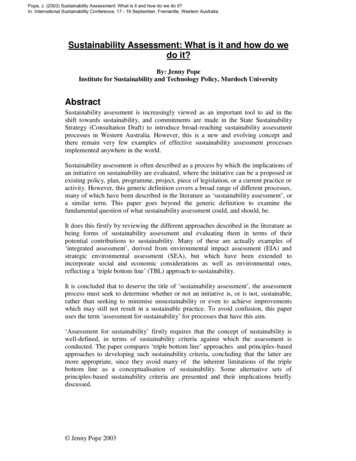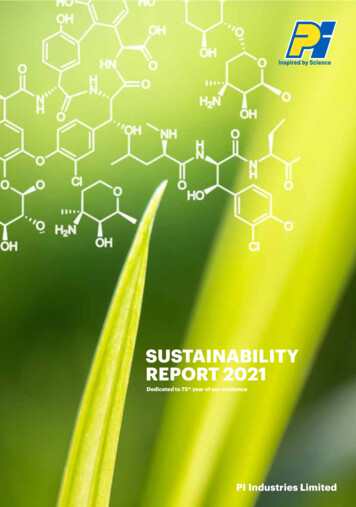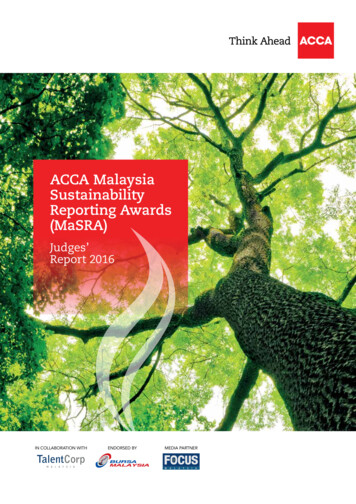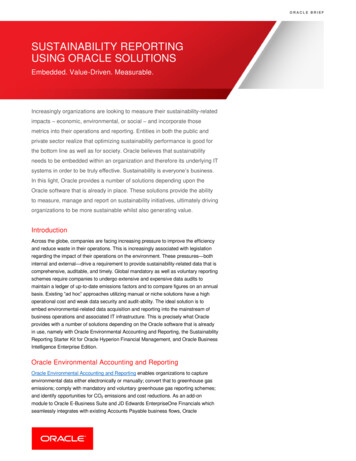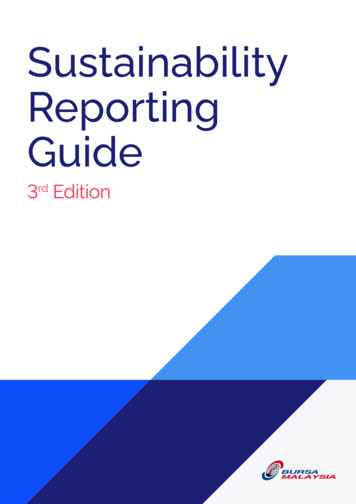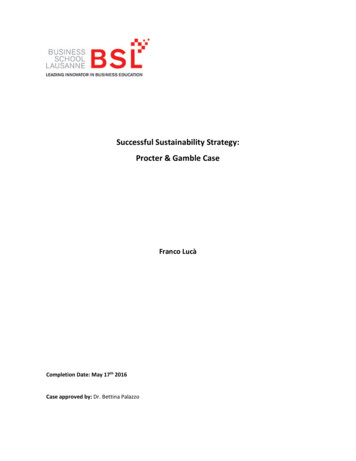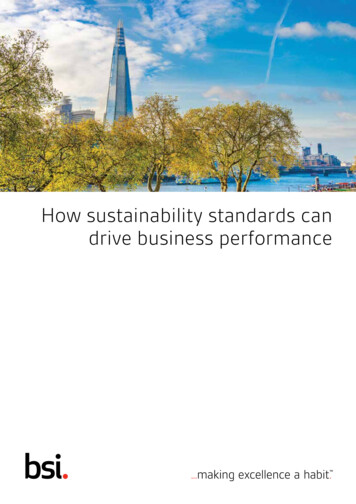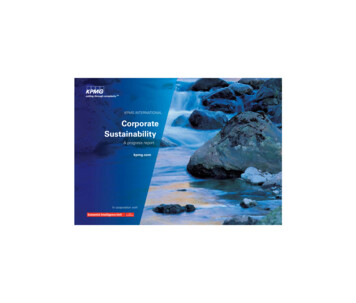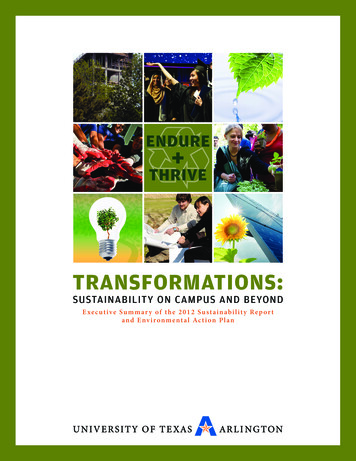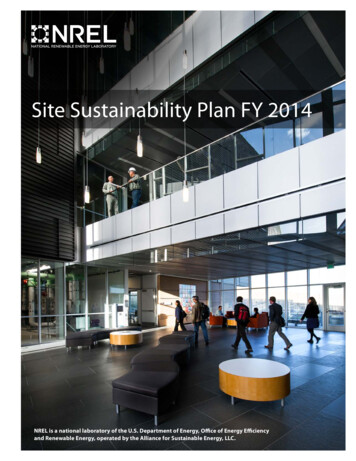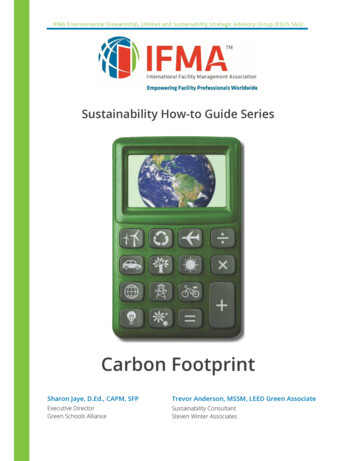
Transcription
IFMA Environmental Stewardship, Utilities and Sustainability Strategic Advisory Group (ESUS SAG)Sustainability How-to Guide SeriesCarbon FootprintSharon Jaye, D.Ed., CAPM, SFPTrevor Anderson, MSSM, LEED Green AssociateExecutive DirectorGreen Schools AllianceSustainability ConsultantSteven Winter Associates
IFMA Environmental Stewardship, Utilities and Sustainability Strategic Advisory Group (ESUS SAG)
IFMA Environmental Stewardship, Utilities and Sustainability Strategic Advisory Group (ESUS SAG)Table of ContentsAcknowledgements .5About the Authors .6Foreword .7IFMA Environmental Stewardship, Utilities and Sustainability Strategic Advisory Group .8Part 1 Executive Summary . 10Part 2 Introduction . 112.1 Carbon Footprint Accounting . 112.2 Why Develop a Carbon Footprint?. 122.3 Climate Neutrality . 122.4 COP21 . 15Part 3 Detailed Findings. 163.1 What Is a Carbon Footprint? . 163.1.1 The Role of the Facility Manager . 163.1.2 Industry Standards . 173.1.3 Sector Models . 203.2 Calculating GHG Inventory . 233.2.1 Basic Principles and Process . 233.2.2 Understanding the Aspects of the Inventory . 233.2.3 Determining Boundaries . 263.2.4 Understanding the Metrics . 283.2.5 Collecting the Data. 283.2.6 Choosing a Calculator . 293.2.7 Analyzing the Results . 353.3 Inventory Management . 363.4 Next Steps . 373.4.1 Metrics . 373.4.2 Benchmarking . 383.4.3 Setting Goals for Reduction (Climate Action Planning) . 403.4.4 Reporting Basics . 423.4.5 External Reporting . 43Part 4 – Making the Business Case . 48Sustainabilit y How t o Guide – Carbon Footprint3
IFMA Environmental Stewardship, Utilities and Sustainability Strategic Advisory Group (ESUS SAG)4.1 Drivers and Benefits . 484.2 Making the Business Case Resources . 50Part 5 Case Studies . 535.1 Agnes Scott College, Decatur, Ga., USA . 535.1.1 Determining Inventory Boundaries. 535.1.2 Data Collection. 535.2 Wesley College, Dover, Del., USA . 565.2.1 Greenhouse Gas Inventory. 565.2.2 Climate Action Plan . 575.3 Massachusetts Water Resources Authority . 585.4 Vassar College . 61Part 6 Appendices . 636.1 Appendix A: References . 636.2 Appendix B: Glossary . 69Sustainabilit y How t o Guide – Carbon Footprint4
IFMA Environmental Stewardship, Utilities and Sustainability Strategic Advisory Group (ESUS SAG)AcknowledgementsThe author would like to thank Eric Teicholz, Bill Conley, Chris Hodges, Laurie Gilmer and AngelaLewis for their contributions to this guide; Kathleen Cacciola, John Fennimore and John Mikullitzwho helped critique and refine this white paper; and Trevor Anderson, who took on the hugetask of updating this guide. Acknowledgement is also given to Susan Kidd and AdrienneD'Agostino for the Agnes Scott College case study and Kathleen Cacciola, Christopher Stemen,Brian Lott and Angie Pauley for the Wesley College case study.– Sharon Jaye, D.Ed., CAPM, SFPThe author would like to thank Sharon Jaye for offering him this opportunity, and theEnvironmental Defense Fund (EDF) Climate Corps Network for its shared pool of knowledge andexperiences. Acknowledgement is also given to Lia Cairone and Nick Garafola for sharing theirEDF Climate Corps projects, to Lia, Denise Breiteneicher, Dede Vittori, and Carolyn Fiore for theMassachusetts Water Resources Authority (MWRA) case study, and to Nick and Alistair Hall forthe Vassar College case study.– Trevor Anderson, MSSM, LEED Green AssociateExternal ReviewersKathleen Cacciola, Senior Director, Environmental Sustainability, Corporate Social Responsibility,ARAMARKBill Conley, CFM, SFP, LEED AP, IFMA Fellow, Owner/Chief Sustainability Officer, CFM2Laurie Gilmer, Associate, Facility Engineering Associates, PCChris Hodges, Principal, Facility Engineering Associates, PCAngela Lewis, Facility Management Diagnostic Specialist, Facility Engineering Associates, PCJohn Mikullitz, ARAMARK Engineering Solutions, Regional DirectorEric Teicholz, IFMA Fellow, President, Graphic Systems, Inc.Editorial BoardAdvisorsEric Teicholz, IFMA FellowBill Conley, IFMA Fellow, CFM, SFP, FMP, LEED APEditorLiv Hadden, Trybal PerformanceSustainabilit y How t o Guide – Carbon Footprint5
IFMA Environmental Stewardship, Utilities and Sustainability Strategic Advisory Group (ESUS SAG)About the AuthorsSharon Jaye, D.Ed., CAPM, SFPExecutive DirectorGreen Schools AllianceSharon Jaye is the executive director of the Green Schools Alliance, based in Washington, DC.She has more than 15 years’ experience in managing sustainable facilities for educationalinstitutions in higher education and K 12 schools. She has a bachelor's degree in businessadministration from Clayton State University, a master's degree in project management from theUniversity of Wisconsin Platteville, and a doctorate of education in educational leadership fromArgosy University. She is a Sustainability Facility Professional through the International FacilityManagement Association (IFMA). Over the years, she has served on multiple IFMA sustainabilitycommittees in different capacities at the international and chapter levels.Trevor Anderson, MSSM, LEED Green AssociateSustainability ConsultantSteve Winter AssociatesTrevor Anderson is a Sustainability Consultant with Steven Winter Associates in New York, NY.He has over 4 years’ experience in the sustainability field, including positions with consulting andcommercial real estate firms, environmental nonprofits and local governments. He has aBachelor’s Degree in Biology and Business Administration from the University of Delaware, anda Master’s Degree in Sustainability Management from the Kogod School of Business at AmericanUniversity. He has worked on sustainability projects pertaining to climate change, energy,agriculture, waste, and the built environment, and has received formal training to identify energyefficiency solutions for facilities. He has also earned the U.S. Green Building Council’s LEED GreenAssociate credential.This Publication is Sponsored by:IFMA Atlanta665 Red OakStockbridge, GA 30281 1 404 766 1632Sustainabilit y How t o Guide – Carbon Footprint6
IFMA Environmental Stewardship, Utilities and Sustainability Strategic Advisory Group (ESUS SAG)ForewordIt is no secret that a focused, well defined sustainability strategy is beneficial to an organization'sbottom line, whether it is a federal, private sector, military or nonprofit entity. Sustainablepractices are not only the right thing to do for the environment; they also benefit thecommunities in which they are implemented. Sustainability is the business implementation ofenvironmental responsibility.Sustainability is all around us. Federal, state and local governments are increasingly applyingregulatory constraints on design, construction and facility operations standards. Employeesexpect their employers to act responsibly, and vice versa. Going green is no longer a fad or atrend, but a course of action for individuals and businesses alike benefiting the triple bottomline of people, planet and profit.Today's facility manager needs to be able to clearly communicate the benefits and positiveeconomic impact of sustainability and energy efficient practices, not only to the public, but alsoto the C suite. While there is a dramatic need for each of us and our organizations to care forthe environment, it is just as important that we convey to executives and stakeholders how theseinitiatives can benefit our company's financial success.The document in your hands is the result of a partnership between the IFMA Foundation andIFMA, through its Environmental Stewardship, Utilities & Sustainability Strategic Advisory Group,each working to fulfill the shared goal of furthering sustainability knowledge. Conductingresearch like this provides both IFMA and the foundation with great insight into what each cando as an organization to assist the facility management community at large.It is my hope that you, as a facility professional, will join us in our mission of furthering sustainablepractices. This resource is a good place to start.Tony Keane, CAEPresident and CEOInternational Facility Management AssociationSustainabilit y How t o Guide – Carbon Footprint7
IFMA Environmental Stewardship, Utilities and Sustainability Strategic Advisory Group (ESUS SAG)IFMA Environmental Stewardship, Utilities andSustainability Strategic Advisory GroupI.PurposeThe Environmental Stewardship, Utilities and Sustainability Strategic Advisory Group (ESS ESUS) serves as an advisoryresource for the integration of the ESS core competency into the practice of facility management. The ESUS SAG isresponsible for the production of IFMA’s Sustainability How to Guide series.II.Direction and AuthorityThe IFMA Board of Directors authorizes the ESUS SAG, within the parameters of its role and responsibilities, to act inan advisory role to the board and the ESUS community in the integration of ESUS into the core competencies of theassociation.III.Role and ResponsibilitiesEnvironmental stewardship and sustainability is a strategic theme and core competency of facility management thattouches every aspect of the association. The primary responsibility of the ESUS SAG is to further the development ofthe ESUS competency area by acting in an advisory capacity with respect to the policies and strategies that pertain toIFMA’s performance as a sustainable organization, development of the ESUS topical area within IFMA’s OnlineCommunity and input on the development of ESUS as a core competency.IV.MembershipSAG members include:* Bill Conley, IFMA Fellow, CFM, SFP, FMP, LEED AP; Laurie Gilmer, P.E., CFM, SFP, LEED AP;Christopher Laughman, CFM, SFP, LEED AP O M; Sheila Sheridan, IFMA Fellow, RCFM, LEED AP; Eric Teicholz, IFMAFellow (ESUS SAG chair); Jenny M. Yeung, CFM, CEnv.*as of April 2016The general objectives of the How to Guides series are:1. To provide data associated with a wide range of subjects related to sustainability, energy savings and thebuilt environment;2. To provide practical information associated with how to implement the steps being recommended;3. To present a business case and return on investment analysis wherever possible, justifying each greeninitiative being discussed;4. To provide information on how to sell management on the implementation of the sustainability technologyunder discussion;5. To provide case studies of successful examples of implementing each green initiative;6. To provide references and additional resources (e.g., websites, articles, glossary) where readers can go foradditional information; and7. To work with other associations for the purpose of sharing and promoting sustainability content.The guides are reviewed by an editorial board, an advisory board and, in most cases, by invited external reviewers.Once the guides are completed, they are distributed for free online by IFMA and the IFMA Foundation.Sustainabilit y How t o Guide – Carbon Footprint8
IFMA Environmental Stewardship, Utilities and Sustainability Strategic Advisory Group (ESUS SAG)IFMA Foundation1 E. Greenway Plaza, Suite 1100Houston, TX 77046 0194Phone: 713 623 4362http://foundation.ifma.orgThe IFMA Foundation originated the Sustainability How to Guide series. The ESUS SAG took over production of theguides in 2014.The mission of the IFMA Foundation is to promote and support scholarships, educational and researchopportunities for the advancement of facility management worldwide. Established in 1990 as a nonprofit, 501(c)(3)corporation, the IFMA Foundation is supported by the generosity of a community of individuals IFMA members,chapters, councils, corporate sponsors and private contributors and is proud to be an instrument of informationand opportunities for the profession and its representatives.A separate entity from IFMA, the IFMA Foundation receives no funding from annual membership dues to carry outits mission. Supported by the generosity of the FM community, the IFMA Foundation provides education, researchand scholarships for the benefit of FM professionals and students. Foundation contributors share the belief thateducation and research improve the FM profession.2014 IFMA Foundation SponsorsMajorMajor benefactors§ East Bay Chapter of IFMAPlatinum sponsor§ A & A Maintenance§ New York Chapter of IFMAGlobal workplace workforce initiative underwriter§ Manhattan Software, a Trimble CompanyGold sponsors§ ARAMARK§ Atlanta Chapter of IFMA§ AquaTech Water Management§ Corporate Facilities Council of IFMA§ Capital Chapter of IFMA § Milliken§ SteelcaseSilver sponsors§ Denver Chapter of IFMA § San Francisco Chapter of IFMABronze sponsors§ Boston Chapter of IFMA § Charlotte Chapter of IFMA§ Corporate Real Estate Council of IFMA§ CORT§ ICS Innovative Cleaning Services § Los Angeles Chapter of IFMA§ Philadelphia Chapter of IFMA§ San Fernando Valley Chapter of IFMA§ Suncoast Chapter of IFMA§ Utah Chapter of IFMAFriends of the foundation§ City and County Clubs Council of IFMA§ Nashville Chapter of IFMA§ Greater Phoenix Chapter of IFMASustainabilit y How t o Guide – Carbon Footprint9
IFMA Environmental Stewardship, Utilities and Sustainability Strategic Advisory Group (ESUS SAG)Part 1 - Executive Summary“Expand knowledge of the built environment, in a changing world, through scholarships,education and research.”The Vision Statement of the IFMA FoundationCarbon has become the currency of the sustainability movement. Whether considering energymanagement, waste handling, environmental impact, purchasing, air quality or a host of othersustainability issues, carbon footprint is the standard measurement of the production ofgreenhouse gases. In the U.S., about 40 percent of carbon emissions can be attributed to theconstruction, operation and maintenance of buildings.This places much of the attention for carbon footprint squarely on the facility manager. Energyconsumption alone accounts for a large portion of the facility footprint. Since energy is usuallythe largest portion of operational cost, the drive to make buildings more energy efficientcoincides directly with the intent to reduce the carbon footprint. The facility manager is in aunique position as the steward of the built environment to measure and monitor both buildingand workplace related carbon emissions.The goal of this guide is to define a carbon footprint and provide facility managers with the toolsneeded to understand the process, analyze the results, and plan for the future. Part 2 of thisguide introduces carbon footprinting and why facility managers need to understand the process.Detailed findings, found in Part 3, define the carbon footprint, the role of the facility managerand current industry standards. It also presents the greenhouse gas (GHG) emission inventoryprocess, including basic principles, boundary determination, collecting data and choosing acalculator. Part 3 finishes with a discussion on best practices, benchmarking, and climate actionplanning and reporting.Part 4 Making the Business Case presents primary drivers, tangible and intangible benefits, andresources for the creation of a business case. Part 5 presents two real world applications ofgreenhouse gas emission inventories and how the organizations individualized the generalprocess.As the issue of greenhouse gas emission accounting is continuously evolving and can varybroadly by country or climate, this guide is not intended to be an all inclusive resource. Readersare encouraged to consult the additional resources provided in the appendices.Sustainabilit y How t o Guide – Carbon Footprint10
IFMA Environmental Stewardship, Utilities and Sustainability Strategic Advisory Group (ESUS SAG)Part 2 - IntroductionSuccessful facility management professionals pride themselves on their ability to stay ahead ofthe curve, to provide the best services and options to their companies and to proactively lookahead at developments and trends that will affect the built environment. Greenhouse gasemission accounting, otherwise known as carbon footprinting, and the reporting and minimizingof these gases is a trend to which attention must be paid. The carbon footprint of anorganization or a facility promises to be a major focal point in the near future dictated bycommon sense, cost savings and legislation. Direct and indirect GHG emissions generated byan organization can be linked to energy consumption and energy costs. Understanding anorganization's carbon footprint will lead to developing the ways and means to cut usage andresultant expenses.2.1 Carbon Footprint AccountingAccounting leads to improved sustainable development outcomes, as it allows organizations orfacilities to measure, track and improve their performance on specific issues. Facility managersare much more likely to effectively manage an issue they can measure. Carbon reporting alsopromotes transparency and accountability. Performance can be monitored periodically andannually and can be compared to other similar organizations.In any facility plan, measurement, verification and documentation should be an ongoing practicein operations; a carbon footprint should be part of any reporting protocol. It will show value infacility efforts while helping to identify opportunities for energy and water efficiency. It will alsoguide in identifying risks while offering the potential to lower facility costs and provide standardsfor material purchasing, waste minimization and reuse.Carbon footprint reporting adds rigor to internal data gathering and information systems byensuring facilities have the baseline information necessary to measure and drive continuousimprovement in their operations. It also will facilitate opportunities to benchmark environmentaland societal performance against other entities. It leads to improved sustainable developmentoutcomes because it allows organizations to measure, track and improve their performance onspecific issues. By taking a proactive role to collect, analyze and report those steps taken by theorganization to reduce potential business risk, companies can remain in control of the messagethey want delivered to shareholders. Public pressure has proven to be a successful method forpromoting behavior and disclosure of GHG emissions, as well as for promoting socialresponsibility.As well as helping organizations manage their impacts, sustainability reporting promotestransparency and accountability. This is due to organizations disclosing information in the publicdomain. In doing so, stakeholders (people affected by, or interested in, an organization'soperation) may track an organization's performance on broad themes, such as environmentalperformance, or a particular issue, such as greenhouse gas emissions.It promotesSustainabilit y How t o Guide – Carbon Footprint11
IFMA Environmental Stewardship, Utilities and Sustainability Strategic Advisory Group (ESUS SAG)organizational learning by making linkages across typically independent functions within a facilitymore apparent, such as finance, quality control, procurement, facilities, human resources,environmental health and safety, and senior management.It also opens value generating internal conversations that otherwise would not occur whileincreasing employee awareness of sustainability issues. This has the potential to enhanceemployee morale and attract new staff. Finally, as the program develops, the tracking effortsand the preparation of reports will lead to a better aware ness of the state of the facility. It willprovide the ability to enhance operations and afford sharing of this information internally, withinthe profession, and/or globally.Sustainability is no longer just a value based question. It is a core strategic imperative for anycompany that intends to thrive and grow in the years ahead. Reporting on a carbon footprintperformance is one important way for organizations to manage their impact on sustainabledevelopment. The challenges of sustainable development are many and it is widely acceptedthat organizations have not only a responsibility but also a great ability to exert positive changeon the state of the world's economy, the environment and social conditions.2.2 Why Develop a Carbon Footprint?Increasingly frequent extreme weather events, record annual global average temperatures anddisruptive seasonal changes in vulnerable countries point to increasing evidence ofanthropogenic climate change. Continued reliance on outdated energy sources, coupled with agrowing population and the emergence of a global middle class, is no longer sustainable oreconomically viable. To achieve economic and development aspirations while also respondingto climate change, nations, businesses and citizens need to rethink current energy policies,practices and actions (World Resources Institute 2011).Organizational GHG inventories quantify the amount of greenhouse gases emitted into theatmosphere and are critical management tools for organizations of all sizes and sectors. Theseinventories enable companies to identify their emission sources and track changes over time.Information presented in an inventory can help inform corporate strategies and prioritizeactions to reduce emissions, as well as provide bench marks against which the success of theseactivities can be measured (World Resources Institute 2011). A report from Groom EnergySolutions and Pure Strategies highlights the top five drivers that motivate a business to track andreport carbon: improved company/brand image, requests from top customers, investorpressure, GHG regulation and cost savings (Groom Energy Solutions 2010).2.3 Climate NeutralityA growing number of organizations are making commitments to climate neutrality – a net zerocarbon footprint. To date, 693 higher education institutions from all 50 U.S. States have signedon to Second Nature’s Carbon Leadership Commitment, an expansion of the American College& University Presidents Climate Commitment (ACUPCC) (Second Nature 2016), pledging toSustainabilit y How t o Guide – Carbon Footprint12
IFMA Environmental Stewardship, Utilities and Sustainability Strategic Advisory Group (ESUS SAG)neutralize their greenhouse gas emissions as soon as possible. The University of California, forexample, is dedicated to reaching carbon neutrality at all of its campuses by 2025 (University ofCalifornia 2013).Pursuing carbon neutrality is a long term journey that must be continued beyond the durationof most current stakeholders. Plans must be aggressive, yet flexible enough to incorporateemerging technologies, energy developments, regulations and markets. Organizations will needto rely heavily on facilities professionals to help develop, initiate, and implement effective climateaction plans.The first priority of facilities committed to climate neutrality must be to internally reduce GHGemissions to the greatest extent possible through energy conservation measures and theinstallation of on site renewable energy generation, and then or simultaneously to address theremaining GHG emissions through purchasing green power and/or carbon offsets. Green Power: Generating on site carbon free, renewable energy may be difficult orunfeasible, and producing enough of it to make a significant difference may be even morechallenging. Therefore, buying green power – the electricity produced from solar, wind,geothermal, biogas, eligible biomass, and low impact small hydroelectric sources(Environmental Protection Agency 2014) – may represent an easier and more cost effectivestrategy for meeting energy demands while reducing the facility carbon footprint. Greenpower purchasing typically involves buying renewable energy credits or certificates (RECs).One REC is equivalent to one Megawatt hour (MWh) of electricity, and represents theproperty rights to the environmental, social, and other non power qualities of renewableelectricity generation (Environmental Protection Agency 2014). To guarantee theirproduction from qualifying renewable energy sources and to ensure they’re not doublecounted and double sold, RECs should be certified by an independent agency, such asCenter for Resource Solution’s (CRS) Green e Energy, the United States’ leading voluntarycertification program for renewable energy. Carbon Offsets: Carbon offsets are credits representing reductions in GHG emissionsmade elsewhere, that may be purchased to compensate for an organization’s own GHGemissions. They can be produced in a variety of ways, including energy efficiency andrenewable energy projects that avoid the release of GHG emissions into the atmosphere,reforestation projects that remove carbon from the atmosphere and sequester it inbiomass, and landfill methane capture and combustion projects that reuse the gas andprevent it from escaping to the atmosphere. An organization may also choose to use itsown resources to create these kinds of projects (Simpson 2009).It’s recommended to purchase carbon offsets incrementally and in appropriate amounts to helpmeet GHG emissions targets that are not fully met from internal emissions reductio
D'Agostino for the Agnes Scott College case study and Kathleen Cacciola, Christopher Stemen, Brian Lott and Angie Pauley for the Wesley Col lege case study. - Sharon Jaye, D.Ed., CAPM, SFP The author would like to thank Sharon Jaye for offering him this opportunity, and the . The general objectives of the Howt o Guides series are: 1. To .
